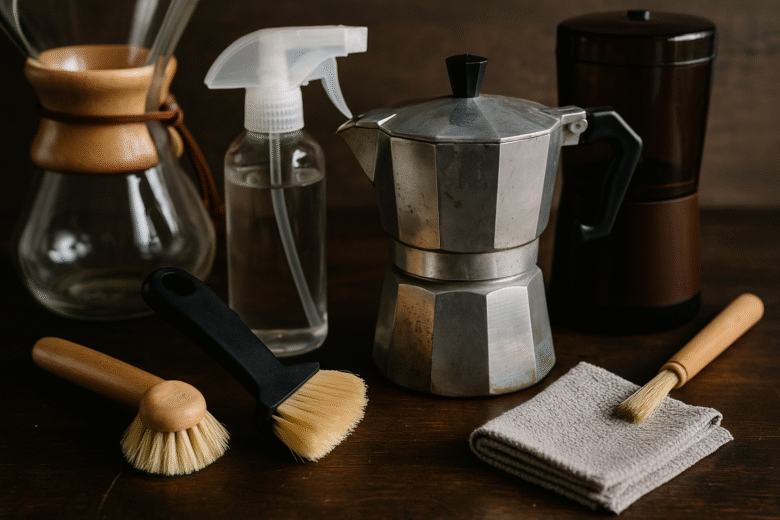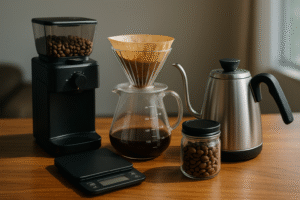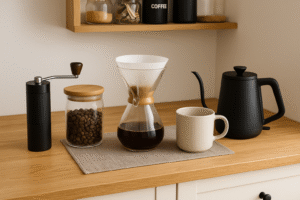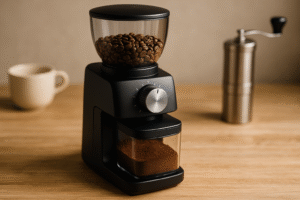Great coffee isn’t just about the beans or the brew method. Clean equipment is just as important. Over time, oils, residue, and mineral buildup can ruin the flavor of your coffee—even if you’re using top-quality beans and gear.
Regular maintenance helps preserve flavor, improve performance, and extend the lifespan of your equipment. Whether you brew with a French press, espresso machine, or pour-over, a clean setup makes all the difference.
In this guide, you’ll learn how to properly clean and maintain the most common types of coffee gear.
Why Clean Equipment Matters
Coffee contains natural oils that build up in your equipment over time. These oils become rancid and produce off-flavors in your brew.
Minerals from water—especially hard water—also accumulate in kettles and espresso machines. This scale buildup affects temperature control and flow rate.
Neglecting cleaning reduces efficiency and makes your gear wear out faster.
Regular cleaning ensures each cup tastes as it should: clean, bright, and true to the bean.
Cleaning Your Grinder
Your grinder sees daily use and is often the most neglected tool in your coffee setup.
How to clean a burr grinder:
- Unplug it and remove the hopper and burrs.
- Use a soft brush or vacuum to remove loose grounds and dust.
- Avoid using water on burrs—unless the manufacturer specifies it’s safe.
- Once a month, run grinder cleaning pellets to clear oils and debris.
For blade grinders, wipe the interior with a damp cloth and dry thoroughly. Use rice or cleaner pellets to absorb residue.
If your grinder smells stale or performs unevenly, it’s time to clean.
Maintaining a French Press
The French press is simple to clean, but it must be done thoroughly to avoid buildup.
After every use:
- Discard the grounds (don’t pour them down the sink).
- Separate the plunger and filter assembly.
- Rinse all parts under hot water and scrub the mesh with a brush.
Weekly deep clean:
- Soak parts in warm water and baking soda or a mild soap.
- Rinse thoroughly and dry completely before reassembly.
Neglecting the mesh filter leads to old oils and clogged screens—both of which affect taste.
Pour-Over and Dripper Care
Pour-over brewers like the Hario V60, Chemex, and Kalita Wave require careful handling, especially when made of glass or ceramic.
Daily cleaning:
- Rinse after each use with warm water.
- Let them air dry upside down to avoid mold in hard-to-reach spots.
Weekly maintenance:
- Soak in a mix of warm water and mild dish soap.
- For stubborn stains, use a soft sponge and baking soda paste.
Avoid harsh abrasives that can scratch surfaces. Clean the carafe, too—especially if it has oily residue inside.
AeroPress Maintenance
The AeroPress is known for being easy to clean.
After brewing:
- Twist off the cap, push the puck of grounds into the trash, and rinse.
- Wash the plunger and chamber under warm water.
Monthly:
- Separate the rubber plunger from the plastic rod.
- Soak all parts in mild soap or vinegar solution, rinse, and air dry.
If the plunger gets sticky or hard to push, it’s time to re-lubricate it by rubbing it lightly with vegetable oil.
Check the rubber seal for wear—replacements are inexpensive and easy to install.
Espresso Machine Cleaning
Espresso machines require more regular and thorough cleaning than other gear.
Daily routine:
- Rinse and wipe the portafilter and basket after every shot.
- Purge the steam wand before and after each use.
- Backflush the group head with clean water (if your machine supports it).
Weekly:
- Backflush with espresso cleaner to remove coffee oils.
- Clean the steam wand with milk cleaner to avoid clogging and bacteria.
Monthly:
- Descale using a descaling solution, especially if you use hard water.
- Remove and clean the shower screen and group gasket.
Follow the manufacturer’s instructions, and don’t ignore descaling alerts.
Cleaning Moka Pots
Moka pots are often misunderstood—they’re not dishwasher-safe and should never be scrubbed with soap.
After each use:
- Disassemble the pot and rinse all parts with warm water.
- Wipe clean with a cloth and dry thoroughly to prevent oxidation.
Monthly:
- Soak in a solution of water and vinegar to remove scale.
- Use a brush to clean the filter and safety valve.
Never let coffee oils sit too long in the chamber—they turn rancid and affect flavor.
Cold Brew Gear and Glassware
Cold brew makers, jars, and bottles require cleaning just like hot brew gear.
After each batch:
- Empty grounds and rinse immediately.
- Wash the container with warm, soapy water and a bottle brush.
Weekly:
- Soak in vinegar solution to remove residue and eliminate odors.
- Pay attention to any rubber seals or mesh filters.
Glass containers can harbor bacteria if not dried properly—leave lids off during drying.
Cleaning Water Kettles
Mineral buildup in kettles affects heat transfer and alters water taste.
Monthly:
- Fill the kettle with equal parts water and vinegar.
- Boil, let sit for 30 minutes, then discard and rinse.
- Boil fresh water once or twice to remove any vinegar smell.
Avoid steel wool on metal surfaces—use a sponge or descaler when needed.
Electric kettles with digital controls may have specific cleaning guidelines. Always consult the manual.
Storage and Preventing Mold
Drying is just as important as washing.
Never store coffee gear when it’s damp. This encourages mold and bacteria.
Store gear in a dry, clean cabinet. Avoid placing anything near stove tops or heat sources that could damage plastic or rubber parts.
If your brewer has gaskets or seals, check for signs of deterioration. Replace as needed to avoid leaks or flavor issues.
Eco-Friendly Cleaning Options
Skip harsh chemicals whenever possible. Try these natural alternatives:
- Baking soda: gentle abrasive cleaner for residue
- White vinegar: descaler and deodorizer
- Lemon juice: mild acid for removing stains and smells
- Dish soap: basic daily cleaner (non-scented preferred)
Compost your grounds instead of trashing them. They make great fertilizer for plants.
Reuse cleaning water to rinse other gear or flush the sink. Reduce waste where you can.
Conclusion: Clean Gear, Clean Taste
No matter how expensive your coffee gear is, it won’t perform without regular maintenance.
Cleaning doesn’t have to be complicated or time-consuming. With a few simple habits, you’ll protect your investment, ensure delicious coffee, and enjoy the brewing process even more.
Take care of your tools, and they’ll take care of your brew.

Marcio Luzardo is a coffee enthusiast and the voice behind Tudo Viraliza. With a passion for turning curiosity into practical knowledge, he shares easy-to-follow tips, guides, and insights to help readers enjoy better coffee every day. When he’s not writing, Marcio is exploring new brewing methods or diving into the rich stories that connect coffee to culture, lifestyle, and wellness.



